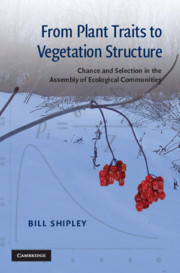 From Plant Traits to Vegetation Structure
From Plant Traits to Vegetation Structure Book contents
- Frontmatter
- Contents
- Preface
- 1 Playing with loaded dice
- 2 Population-based models of community assembly
- 3 Trait-based community ecology
- 4 Modeling trait-based environmental filters: Bayesian statistics, information theory and the Maximum Entropy Formalism
- 5 Community dynamics, natural selection and the origin of community-aggregated traits
- 6 Community assembly during a Mediterranean succession
- 7 The statistical mechanics of species abundance distributions
- 8 Epilogue: traits are not enough
- References
- Index
- References
2 - Population-based models of community assembly
Published online by Cambridge University Press: 05 June 2012
- Frontmatter
- Contents
- Preface
- 1 Playing with loaded dice
- 2 Population-based models of community assembly
- 3 Trait-based community ecology
- 4 Modeling trait-based environmental filters: Bayesian statistics, information theory and the Maximum Entropy Formalism
- 5 Community dynamics, natural selection and the origin of community-aggregated traits
- 6 Community assembly during a Mediterranean succession
- 7 The statistical mechanics of species abundance distributions
- 8 Epilogue: traits are not enough
- References
- Index
- References
Summary
I approach this chapter with trepidation. Since the model proposed in this book is rather different from traditional models in community ecology, I want to discuss those aspects of model-building that will allow you to judge it relative to others. It might be fun to embark on a long-winded discussion about the philosophy of modeling in ecology, but only on a Friday afternoon, only if accompanied by cool beer and good friends, and especially if done in moderation. Since these conditions are not present (except, I hope, for the presence of friends) I will be brief.
Another reason why I am uneasy with this chapter is that I want to avoid giving the impression that I view previous modeling attempts in community ecology to be useless. On the contrary, these previous attempts were inspired (and have inspired me) and are of high quality. At the same time, it is important that I contrast my approach with previous ones. It is important that you understand both the differences with other models and also why I think that previous modeling approaches have failed, at least by the criteria that I am using. After all, if even I don't think that the approach is an advance over previous attempts then why should you invest your time in reading this book? I reconcile these two contradictory messages by appealing to the nature of scientific research.
- Type
- Chapter
- Information
- From Plant Traits to Vegetation StructureChance and Selection in the Assembly of Ecological Communities, pp. 10 - 35Publisher: Cambridge University PressPrint publication year: 2009


